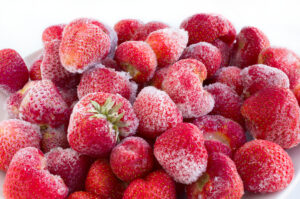| By Ryan Maus |
A new outbreak of hepatitis A virus has been associated with frozen organic strawberries and sickened five people (with two hospitalizations) from the state of Washington. The strawberries were distributed to numerous retail locations across the country, sometimes comingled with other fruit products. This has led to numerous recalls of products with best by dates as far away as November 2024. The ongoing outbreak serves as a reminder of the hazard viruses can present for certain ingredients and the subsequent products (such as smoothies and juice) in which they are often used.
Outbreaks of hepatitis A are generally reported after epidemiological evidence points to a common food or water source. The virus replicates inside human host cells and is shed in human feces. The virus does not multiply in or on foods but can be transmitted by food and water contaminated with human fecal material. Several fecal-oral scenarios leading to an outbreak include contaminated irrigation or wash water, sick field workers during harvest, or ready-to eat products contaminated by sick food handlers. The current outbreak strain of hepatitis A virus is genetically identical to the hepatitis A strain found in fresh organic strawberries that caused an outbreak in 2022. Organic strawberries in both outbreaks were sourced from farms located in Baja California, Mexico.
Hepatitis A Foodborne Outbreaks (Source FDA and CDC)
| Year | Product | Virus | Illness |
|---|---|---|---|
| 2023 2022 2019 2017 2016 2016 2013 | Frozen Strawberries Frozen Strawberries Fresh Blackberries Frozen Tuna Frozen Strawberries Raw Scallops Pomegranate Seeds | Hepatitis A Hepatitis A Hepatitis A Hepatitis A Hepatitis A Hepatitis A Hepatitis A | 5 (currently) 18 20 Unknown 143 292 162 |
Berries contaminated with hepatitis A can also pose a hazard when processed into products such as fresh fruit smoothies or juice. A recent warning letter was issued to a juice manufacturer that used contaminated strawberries in the formulation of a high pressure processed (HPP) juice product. The manufacturer did not validate that the HPP treatment would produce the required minimum 5-log reduction to control the target pathogen (hepatitis A virus). Generally, cooking food until it’s at a
temperature of 190˚F in the middle for at least 1½ minutes or boiling food in water for at least 3 minutes inactivates the virus. However, if present, the virus is very hardy and can survive on food, in water, and on environmental surfaces for extended periods of time. Hepatitis A illness usually begins about 2-4 weeks after exposure causing symptoms of fever, low appetite, nausea, vomiting, diarrhea, muscle aches, and jaundice. The virus can clear on its own within a week or two.
However, in some instances, the infection can last up to 6 months and cause inflammation and damage to the liver. Although the virus cannot grow in the
environment, it is considered to be extremely stable under a wide range of environmental conditions, including freezing, heat, desiccation, and chemicals. Concentrations of disinfectants commonly used against pathogenic bacteria might not be effective. A vaccine for the virus has provided a reasonable control measure to prevent the spread of hepatitis A. Preventive measures generally include good food handler hygiene, supplier verification programs, use of potable water, thermal processing, and proper sanitation.


